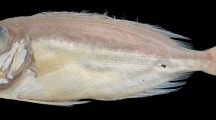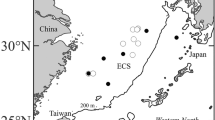Abstract
Gnomefish Scombrops boops and Scombrops gilberti are commercially important fishes in Japan, but these species are often confused in the markets because of their morphological similarity. To identify these two species, we performed nucleotide sequencing and restriction fragment length polymorphism (RFLP) analysis on 16S ribosomal RNA (rRNA) gene and the control region in mitochondrial DNA. Five and 12 nucleotide substitutions were observed between species in the 777-bp 16S rRNA gene and 471-bp control region, respectively. Diagnostic restriction sites for discriminating between S. boops and S. gilberti were found in the 16S rRNA gene, but not in the control region. Polymerase chain reaction (PCR)-RFLP analysis using two enzymes, EcoNI and Mval, clearly discriminated between S. boops and S. gilberti identified by meristic characters. The PCR-RFLP analysis identified most of the 168 Scombrops young caught in the coastal waters of the Izu and Miura peninsulas as S. boops, suggesting that S. gilberti juveniles are rare in this area.
Similar content being viewed by others
References
Shao K-T. First record of Scombropidae (Pisces: Percoidei) from Taiwan. Bull. Inst. Zool., Academia Sinica 1987; 26: 191–194.
Hayashi K. Scombropidae. In: Nakabo T (ed.). Fishes of Japan with Pictorial Keys to the Species, 2nd edn. Tokai University Press, Tokyo, 2000; 786.
Yasuda F, Mochizuki K, Kawajiri M, Nose Y. On the meristic and morphometric differences between Scombrops boops and S. gilberti. Jpn. J. Ichthyol. 1971; 18: 118–124.
Kawashima N, Hasegawa M, Takagi Y. Fish resource estimation. In: Report during the Fiscal Year of 2001 (Jigyohokoku). Shizuoka Prefectural Fisheries Experimental Station. Yaizu, Japan. 2002; 87–91 (in Japanese).
Mochizuki K. Family Scombropidae. In: Masuda H, Amaoka K, Araga C, Uyeno T, Yoshino T (eds). The Fishes of the Japanese Archipelago. Tokai University Press, Tokyo. 1984; 152, pl. 135-F.
Abe T. Illustrated Fishes of the World in Colour. Hokuryukan Co., Tokyo. 1987; 532 (in Japanese).
Tanaka T, Meguro K. Utilization of stock on Japanese bluefish caught in the coastal waters in Chiba Prefecture and the Izu Islands Sea area. Bull. Chiba Pref. Fish. Res. Cen. 2004; 3: 7–16 (in Japanese).
Sezaki K, Begum RA, Wongrat P, Srivastava MP, SriKantha S, Kikuchi K, Ishihara H, Tanaka S, Taniuchi T, Watabe S, Molecular phylogeny of Asian freshwater and marine stingrays based on the DNA nucleotide and deduced amino acid sequences of the cytochrome b gene. Fish. Sci. 1999; 65: 563–570.
Itoi S, Saito T, Washio S, Shimojo M, Takai N, Yoshihara K, Sugita H. Speciation of two sympatric coastal fish species, Girella punctata and Girella leonina (Perciformes, Kyphosidae). Org. Divers. Evol. 2007; 7: 12–19.
Itoi S, Saito T, Shimojo M, Washio S, Sugita H. Identification of Girella punctata and G. leonina by PCR-RFLP analysis. ICES J. Mar. Sci. 2007; 64: 328–331.
Palumbi S, Martin A, Romano S, McMillan WO, Stice L, Grabowski G. The Simple Fool’s Guide to PCR, Version 2. Department of Zoology and Kewalo Marine Laboratory, University of Hawaii, Honolulu, HI, 1991.
Thompson JD, Higgins DG, Gibson TJ. CLUSTAL W: improving the sensitivity of progressive multiple sequence alignment through sequence weighting, position-specific gap penalties and weight matrix choice. Nucleic Acids Res. 1994; 22: 4673–4680.
Saitou N, Nei N. A neighbor-joining method: a new method for constructing phylogenetic tree. Mol. Biol. Evol. 1987; 44: 406–425.
Jordan DS, Snyder JD. A list of Japanese fishes. Proc. U.S. Nat. Mus. 1901; 23: 739–769, pls 31–38.
Jordan DS, Snyder JD. Cardinal fishes of Japan. Proc. U.S. Nat. Mus. 1901; 24: 891–913, pls 63–64.
Tanaka S. On the distribution of fishes in Japanese waters. J. Fac. Sci. Imp. Univ. Tokyo, Sec. 4, Zool. 1931; 3: 1–90, pls 1–3.
Oshima M. Fish. Sanseido, Tokyo. 1939; 661 (in Japanese).
Author information
Authors and Affiliations
Corresponding author
Rights and permissions
About this article
Cite this article
Itoi, S., Takai, N., Naya, S. et al. Species identification method for Scombrops boops and Scombrops gilberti based on polymerase chain reaction-restriction fragment length polymorphism analysis of mitochondrial DNA. Fish Sci 74, 503–510 (2008). https://doi.org/10.1111/j.1444-2906.2008.01552.x
Received:
Accepted:
Issue Date:
DOI: https://doi.org/10.1111/j.1444-2906.2008.01552.x




